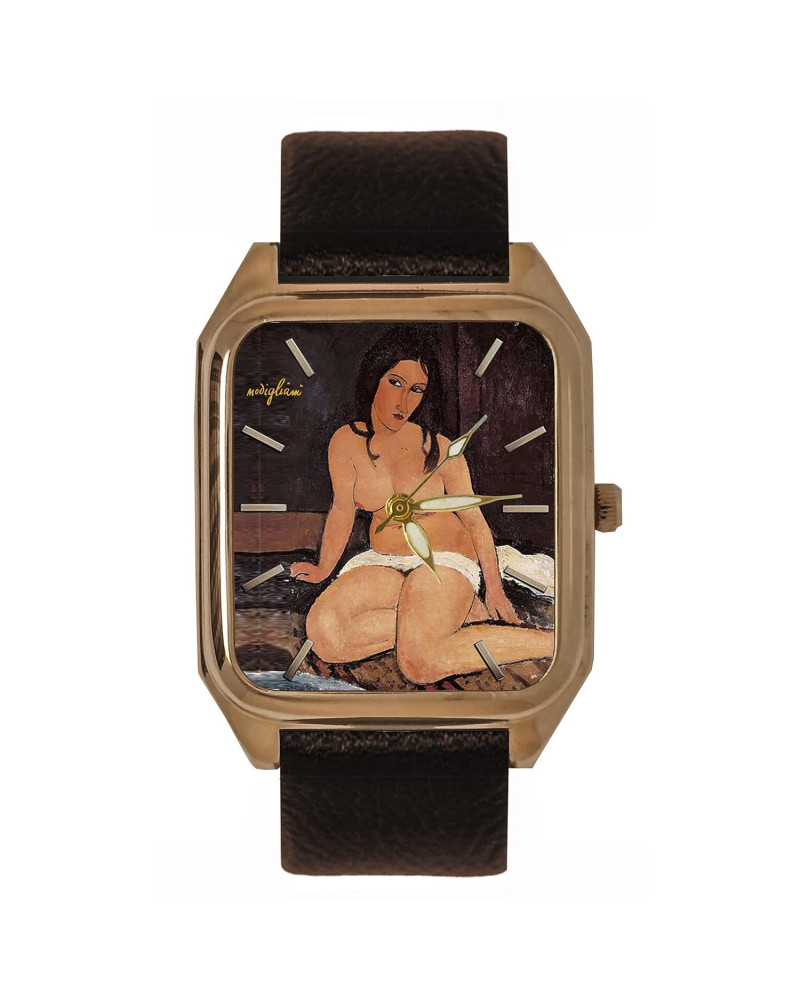




⦿ 34 mm medium-sized unisex solid brass case with scratchproof mineral glass crystal and stainless steel back.
⦿ Premium Citizen 2040 quartz movement, uses easy to find regular watch LR44 batteries.
⦿ Hypoallergenic leather bracelet with matching brass buckle.
⦿ Handmade American pinewood presentation / souvenir / gift box with velvet cushion and brass clasp.
⦿ Unique collectible Limited Edition handmade watches with great investment potential.
⦿ All customization requests will be considered.
Amedeo Modigliani’s name is often spoken with reverence in the art world — not just for his unique style but for the intense sensuality that radiates from his paintings and drawings. His nudes are among the most recognizable in modern art, both celebrated and censored, and at the heart of it all is a fearless exploration of the erotic. But what makes Modigliani’s eroticism so distinct — even in the bawdy context of early 20th-century Paris — is not vulgarity or provocation, but a deep reverence for the body, especially the female form.
Modigliani painted the nude not as an object of desire, but as a subject of devotion. His women do not flinch under the viewer's gaze. They lie back, stretch, fold, recline — not to seduce but to exist. In works like Nu couché (Reclining Nude) (1917), the subject meets the viewer’s eyes directly, fully nude, wholly unashamed. There is no drapery to soften the scene, no classical allegory to veil the intimacy — just the truth of skin, curve, and posture.
What makes these works erotic is not simply their nudity, but the way the body is treated. The limbs are elongated, the faces stylized, yet there is a palpable sense of warmth and flesh. Modigliani’s line is fluid and affectionate — a contour that caresses rather than defines. There is a soft defiance in the way he draws a breast or a hip: not as an accessory to beauty, but as a thing complete unto itself.
In Modigliani’s time, the erotic nude was still filtered through moral and academic codes. Art was full of mythological nudes — Venuses and nymphs who allowed male artists to explore eroticism under the guise of classicism. Modigliani had no use for that. His women are not goddesses or symbols. They are lovers, workers, muses, Parisians. They are real.
This realism disturbed the early 20th-century audience. When Modigliani’s only solo exhibition opened in Paris in 1917, the police shut it down on opening day due to the display of nudes in the gallery window. The reaction was not to their nudity alone, but to their frankness. There was no coyness or spiritual metaphor to mask their eroticism. These were modern women in a modern city, painted as they were.
Eroticism in Modigliani’s art was not detached from his personal life. His partner, Jeanne Hébuterne, became not only his muse but his co-conspirator in art and love. She appears again and again in his portraits — her long neck, almond eyes, and introspective expression mirrored his aesthetic ideals.
Yet Modigliani rarely painted her nude. In a way, she occupied a different sphere — the romantic rather than the erotic. For his nudes, he often hired models from Montparnasse’s lively bohemian quarters. These women became icons not only of sensuality but of a kind of psychological depth. Their faces may be mask-like, but their bodies are alive with subtle tension and tenderness.
Modigliani’s style was deeply influenced by African masks and Cycladic sculptures. These influences merged into a visual language where simplification of form emphasized the essential — and in doing so, heightened erotic impact. A single curved line might define a thigh, a shadow might imply an entire gesture.
This paring down to essentials mirrors how eroticism operates in Modigliani’s work: not through explicitness but through suggestion. A turned head, an exposed ribcage, a deep gaze — these small choices accumulate to form an atmosphere of intimacy. The erotic in Modigliani is never loud. It is quiet, smoldering, and sincere.
What separates Modigliani’s eroticism from pornography is not just intent but empathy. His nudes never seem exploited. They are offered to the viewer, yes — but not consumed. Their nudity does not erase their interiority. In fact, they seem to own their eroticism. This autonomy — rare in art of the time — feels strikingly modern.
Before the feminist gaze became a lens through which art was critiqued, Modigliani’s work stood at an unusual intersection: male-authored but not male-dominated, sensuous but not possessive. His women, even in their nakedness, are neither powerless nor idealized. They are erotic because they are fully human.
Amedeo Modigliani’s art remains an extraordinary testament to the power of eroticism when filtered through empathy, style, and an unwavering devotion to the human form. His nudes scandalized the conservative and captivated the open-minded — and they continue to do both. What endures is not just their beauty, but their bravery: a celebration of the erotic without shame, sentimentality, or disguise.